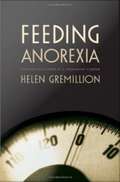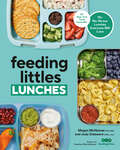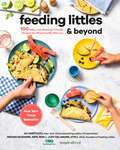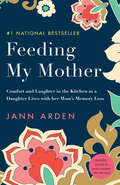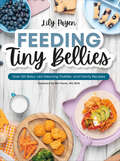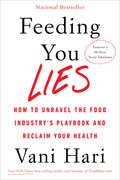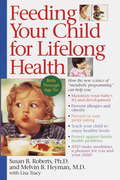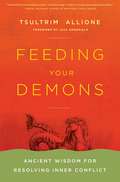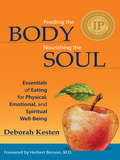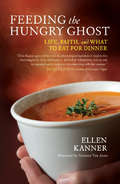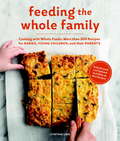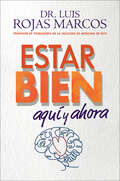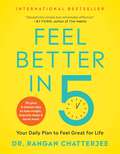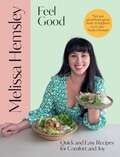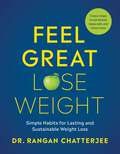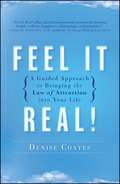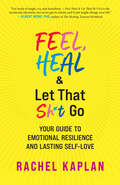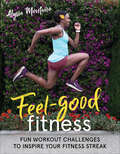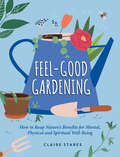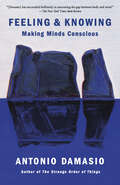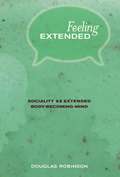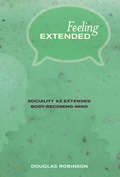- Table View
- List View
Feeding Aorexia: Gender and Power at a Treatment Center
by Helen GremillionFeeding Anorexia challenges prevailing assumptions regarding the notorious difficulty of curing anorexia nervosa. Through a vivid chronicle of treatments at a state-of-the-art hospital program, Helen Gremillion reveals how the therapies participate unwittingly in culturally dominant ideals of gender, individualism, physical fitness, and family life that have contributed to the dramatic increase in the incidence of anorexia in the United States since the 1970s. She describes how strategies including the meticulous measurement of patients' progress in terms of body weight and calories consumed ultimately feed the problem, not only reinforcing ideas about the regulation of women's bodies, but also fostering in many girls and women greater expertise in the formidable constellation of skills anorexia requires. At the same time, Gremillion shows how contradictions and struggles in treatment can help open up spaces for change. Feeding Anorexia is based on fourteen months of ethnographic research in a small inpatient unit located in a major teaching and research hospital in the western United States. Gremillion attended group, family, and individual therapy sessions and medical staff meetings; ate meals with patients; and took part in outings and recreational activities. She also conducted over one hundred interviews-with patients, parents, staff, and clinicians. Among the issues she explores are the relationship between calorie-counting and the management of consumer desire; why the "typical" anorexic patient is middle-class and white; the extent to which power differentials among clinicians, staff, and patients model "anorexic families"; and the potential of narrative therapy to constructively reframe some of the problematic assumptions underlying more mainstream treatments.
Feeding Littles Lunches: 75+ No-Stress Lunches Everyone Will Love: Meal Planning for Kids
by Megan McNamee Judy Delaware75+ simple and delicious ideas for packed school lunches and snacks for kids of all ages, from the New York Times bestselling authors of Feeding Littles and Beyond.In a lunch packing rut? Megan McNamee and Judy Delaware, the founders of Feeding Littles, are here to help with the ultimate lunch box resource. Feeding Littles Lunches is complete with 75+ lunches that are quick to assemble, safe and easy for kids of all ages to eat, and balanced in nutrients for growth, learning and play. Each lunch idea is easily modified for nine of the most common allergens and includes tips for picky eaters, plus vegetarian swaps and &“I Can&’t Even&” tips to make lunch packing even easier. Feeding Littles Lunches is not a recipe book because, let&’s face it, most parents don&’t want to spend hours packing lunches. Rather, it&’s an inspo book with a full-page photo for every lunch, meant to be used with your child as a visual reminder for delicious and easy new ideas that you can assemble from simple ingredients. Feeding Littles Lunches also includes a lunch packing formula to help you plan your own lunches, grocery lists, tips for dealing with cafeteria and school settings, picky eating, food safety, and more! With creative and approachable lunches like Chicken Salad with Mini Brioche Toasts, Sun Butter Banana Roll-Up &“Sushi-Style,&” Build-Your-Own Naan Pizza, Leftover Burger Mini Sliders, Pesto Turkey Wrap Rounds, and more, you&’ll bring joy back to lunchtime.
Feeding Littles and Beyond: 100 Baby-Led-Weaning-Friendly Recipes the Whole Family Will Love
by Ali Maffucci Megan McNamee Judy DelawareAn inspirational, accessible family cookbook that offers everything a parent needs to bring joy and love back into the kitchen, by the baby and toddler feeding experts behind Feeding Littles and the New York Times bestselling cookbook author of Inspiralized.When it was time to introduce solids to her firstborn, Ali Maffucci didn&’t want to make baby food from scratch or buy expensive premade purées. Enter baby-led weaning (or baby-led feeding)—and Megan McNamee and Judy Delaware, the dietitian/occupational therapist duo behind preeminent parenting resource Feeding Littles—which skips spoon-feeding altogether so babies can eat what the family eats. As babies feed themselves, they explore a variety of aromas, shapes, and colors while developing fine motor skills, hand-eye coordination, dexterity, and healthy eating habits. McNamee and Delaware also help their clients navigate—or prevent—picky eating at all ages and raise a generation of intuitive eaters who listen to their bodies and love a variety of food. Now, these powerhouse authors unite to provide a plan that will reduce stress and anxiety around mealtimes, nourish your loved ones, and satisfy everyone&’s palate with fun, easy, nutritious recipes. Maffucci, Delaware, and McNamee offer:strategies for baby-led weaning/feeding, as well as safety and other common parental concernshow to meal-prep in a way that works for your scheduletips for dealing with challenges such as picky eaters and dining outa one-of-a-kind visual index for plating food that babies can feed to themselves100+ delicious recipes in categories including Morning Fuel (with plenty of egg-free options), Less Is More (using five ingredients or less), and Mostly Homemade (no shame in using pantry staples!)modifications for families with allergiespositive food language and how to promote body positivityand much moreWith this book in hand, mealtimes will be easier and more enjoyable for everyone—from your six-month-old, to your picky toddler, to the other kids and adults in the family. As parents, the authors know that getting food on the table is hard enough, so whether you&’re making a five-minute grilled cheese or pumpkin waffles, it&’s time to start celebrating every bite.
Feeding My Mother: Comfort and Laughter in the Kitchen as My Mom Lives with Memory Loss
by Jann ArdenBased on her hugely popular Facebook posts and Instagram photos, Feeding My Mother is a frank, funny, inspirational and piercingly honest account of the transformation in Jann Arden's life that has turned her into the primary "parent" to her mom, who is in the grip of Alzheimer's.Jann Arden moved in to a house just across the way from her parents in rural Alberta to be close to them but also so they could be her refuge from the demands of the music business and a performing career. Funny how time works. Since her dad died in 2015, Jann cooks for her mom five or six times a week. Her mom finds comfort in her daughter's kitchen, not just in the delicious food but also just sitting with her as she cooks. And Jann finds some peace in caring for her mom, even as her mom slowly becomes a stranger. "If you told me two years ago that I'd be here," Jann writes, "I wouldn't have believed it. And yet we still fall into so much laughter, feel so much insane gladness and joy. It's such a contrast from one minute to the next and it teaches me constantly: it makes me stronger and more humble and more empathetic and caring and kind." The many people who are dealing with a loved one who is losing it will find inspiration and strength in Jann's wholehearted, loving response and her totally Jann take on the upside-down world of a daughter mothering her mother. Feeding My Mother is one heck of an affirmation that life just keeps on keeping on, and a wonderful example of how you have to roll with it.
Feeding Tiny Bellies: Over 100 Baby-Led Weaning, Toddler, and Family Recipes: A Cookbook
by Lily PayenA unique baby-led weaning cookbook from Lily Payen of Feeding Tiny Bellies, with over 100 easy recipes for feeding little ones and beyondLily Payen, the mama behind the popular baby-led weaning website Feeding Tiny Bellies, knows how challenging it can be to start feeding solids to your baby. When Lily was a new parent faced with offering solids to her baby for the first time, she was lost on where to start, what to feed him, and how to balance making meals for the entire family. Through trial and error—and two more babies—Lily figured out what worked and what didn't. She created her website, and now, this cookbook, to help other parents and caregivers make meals they can feel confident about serving to their little ones. The 100+ simple recipes—from Strawberry Oatmeal Bars to Avocado Chicken Salad to Parmesan-Crusted Salmon—are designed for babies six months of age who are beginning solids, and each recipe includes tips for modifying and safely serving portions for babies.Lily guides you through the weaning journey, addressing the most commonly asked questions and providing advice for parents of picky eaters, children with allergies, and more. This book is your one-stop shop for creating delicious recipes that the whole family will love.
Feeding You Lies: How to Unravel the Food Industry's Playbook and Reclaim Your Health
by Vani HariThis follow-up to New York Times bestseller The Food Babe Way exposes the lies we've been told about our food--and takes readers on a journey to find healthy options.There's so much confusion about what to eat. Are you jumping from diet to diet and nothing seems to work? Are you sick of seeing contradictory health advice from experts? Just like the tobacco industry lied to us about the dangers of cigarettes, the same untruths, cover-ups, and deceptive practices are occurring in the food industry. Vani Hari, aka The Food Babe, blows the lid off the lies we've been fed about the food we eat--lies about its nutrient value, effects on our health, label information, and even the very science we base our food choices on. You'll discover: • How nutrition research is manipulated by food company-funded experts • How to spot fake news generated by Big Food • The tricks food companies use to make their food addictive • Why labels like "all natural" and "non-GMO" aren't what they seem and how to identify the healthiest food • Food marketing hoaxes that persuade us into buying junk food disguised as health foodVani guides you through a 48-hour Toxin Takedown to rid your pantry, and your body, of harmful chemicals--a quick and easy plan that anyone can do. A blueprint for living your life without preservatives, artificial sweeteners, additives, food dyes, or fillers, eating foods that truly nourish you and support your health, Feeding You Lies is the first step on a new path of truth in eating--and a journey to your best health ever.
Feeding Your Child for Lifelong Health
by Susan RobertsHow the new science of "metabolic programming" can help you: Maximize your baby's IQ and development / Prevent allergies and obesity / Prevent or cure picky eating / Teach your child to enjoy healthy foods / Protect against family health problems AND make mealtimes a pleasure for you and your child! In this groundbreaking book, two leading pediatric nutritionists--and experienced parents!--introduce exciting new research into "metabolic programming" and make it accessible and practical for every busy parent. They explain: How the foods you choose can optimize your baby's future development, IQ bone strength, and immunity / The eight key nutrients to focus on / Scientifically based "smart strategies" for working with your child's inborn instincts to build healthy eating habits / Food solutions for common problems--including colic, constipation, poor sleep, and hyperactivity / How to prevent or deal with food allergies or obesity / Easy ways to adapt family meals for kids--with menus and portion sizes for every stage from birth through age six, plus essential tips for food safety. What's more, you can teach your child to enjoy these healthy foods and banish food battles and picky eating forever. (From the Trade Paperback edition.)
Feeding Your Demons: Ancient Wisdom for Resolving Inner Conflict
by Tsultrim AllioneTsultrim Allione brings an eleventh-century Tibetan woman's practice to the West for the first time with FEEDING YOUR DEMONS, an accessible and effective approach for dealing with negative emotions, fears, illness, and self-defeating patterns. Allione-one of only a few female Buddhist leaders in this country and comparable in American religious life to Pema Chodron-bridges this ancient Eastern practice with today's Western psyche. She explains that if we fight our demons, they only grow stronger. But if we feed them, nurture them, we can free ourselves from the battle. Through the clearly articulated practice outlined in FEEDING YOUR DEMONS, we can learn to overcome any obstacle and achieve freedom and inner peace.
Feeding a Family: A Real-Life Plan for Making Dinner Work
by Sarah Waldman40 seasonal meals, 100 recipes, and loads of tips and strategies to make weeknight dinners work Reclaim the family dinner! In Feeding a Family, nutritionist and mom Sarah Waldman lays out all the tools you need to break out of the mealtime rut and turn dinner into a nutritionally fulfilling and happy occasion—despite busy schedules, long work days, and picky eaters. Through forty complete meals, you’ll discover hearty dinners the whole family will love, including: · A meal for using up the best summer garden produce: Make-ahead Zucchini, Beef, and Haloumi Cheese Skewers with Chimichurri Sauce paired with Tomato, Peach, and Red Onion Panzanella and Lemon-Blackberry Custard · A cozy and comforting dinner for a frenzied fall day: Creamy Tomato and Spinach Soup with Grilled Cheese Croutons and Pear Pie in Cornmeal Crust · The perfect meal for the busiest night of the week: Slow Cooker Indian Butter Chicken with Sweet Peas and Lemon-Pecan Shortbread Cookies · A warming (and fun) winter meal: One-pot Slurpee Noodle Bowls with simple Chocolate, Peanut Butter, and Date Truffles for dessert · Sunday suppers for when you have a bit more time to play in the kitchen, such as Homemade Pasta with Heirloom Tomato Sauce and Pavlova with BlueberriesWith suggestions for including older kids in mealtime prep, tips for feeding baby, and ideas for extending ingredients for “tomorrow’s dinner,” Feeding a Family is a playbook that includes the whole family.
Feeding the Body, Nourishing the Soul: Essentials Of Eating For Physical, Emotional And Spiritual Well-being
by Deborah KestenFeeding the Body, Nourishing the Soul leads us back to a deeper and healthier relationship to eating by drawing on ancient food wisdom from the world's religions and cultures. From Jewish dietary laws and the communion of Christianity to the food-based spiritual practices of Islam, Hinduism, and the Japanese tea ceremony, among many others, author Deborah Kesten shows how to create a more satisfying, spiritually oriented approach to food. Also includes cutting-edge scientific research on the life-giving properties of food, and fascinating insights from more than 45 scientists and spiritual teachers, including Jon Kabat-Zinn and Larry Dossey, to focus our attention on how to prepare both food and your state of mind so that you are nourished optimally.
Feeding the Frasers: Family Favorite Recipes Made to Feed the Five-Time CrossFit Games Champion, Mat Fraser
by Sammy MonizBased on Sammy Moniz's popular Instagram page, Feeding the Frasers is a book that any CrossFit aficionado—or just someone curious about how to cook with whole foods without sacrificing the world—will want to get their hands on.Filled with 100 terrific recipes of high quality delicious food that promote balance, togetherness, indulgence, and athletic recovery. Sammy Moniz is well known in the CrossFit community as an activist, and she is also the wife of five time champion Mat Fraser, the winningest athlete in CrossFit history and one of the most beloved. This is her cookbook where she shares the secrets behind feeding the greatest champion of the sport.
Feeding the Hungry Ghost
by Ellen KannerA combination of writing about food and food traditions, descriptions of cultural and religious traditions where food is central (from Haiti soup night to a recipe for a dish to break the fast of Ramadan). The book is broken into parts: seeds; flowering; harvest; compost. She includes Judeo-Christian, Haitian, Turkish, Muslim, African, Mexican, traditions, both religious and secular, around food and how people use food to soothe, celebrate, commemorate, grieve, and connect with each other. The author is active in the sustainable eating movement and writes regularly for the Huffington Post (meatless Monday blog); Gourmet; and local Miami newsletters.
Feeding the Whole Family: More than 200 Recipes for Feeding Babies, Young Children, and Their Parents
by Cynthia LairFor nearly 15 years, Cynthia Lair's iconic cookbook Feeding the Whole Family has been the source for parents who want to cook one healthy meal for the entire family, including babies. Feeding the Whole Family starts with the basics of creating a whole foods diet, from understanding grains and beans to determining what meats are acceptable to eat. Lair then applies these lessons to cooking for young children and babies aged six months and older. In each recipe, Lair offers special instruction on how to adapt it so that younger children can enjoy the dish while parents can eat a more complicated version. All recipes utilize easy-to-find ingredients, are simple to follow, and will be enjoyable for both child and parent. With a new foreword by Mothering magazine's editor and founder Peggy O'Mara, Feeding the Whole Family is a necessary staple for all families.
Feel Better \ Estar bien (Spanish edition): Aquí y ahora
by Luis Rojas Marcos¿Existen pensamientos y creencias que tienen un impacto directo en nuestro organismo y nos hacen enfermar? ¿Se pueden gestionar las emociones que nos producen miedo, angustia o tristeza? ¿Cómo superar las heridas del pasado para gestionar nuestro presente y ver nuestro futuro con esperanza?¿Qué puedo hacer para estar y sentirme bien? En una de las etapas de la humanidad de mayor incertidumbre y miedo, Luis Rojas Marcos, uno de los psiquiatras más prestigiosos y reconocidos a nivel mundial publica el manual definitivo para alcanzar el equilibro mental y lograr una vida más saludable y feliz.En Estar bien entenderás la importancia que tiene adoptar un estilo de vida optimista, cómo proteger la autoestima, el poder de la resiliencia, la importancia de las relaciones afectivas, por qué la gratitud y la solidaridad son claves en nuestra salud.Una obra imprescindible, clara y práctica que ayudará a gestionar nuestras emociones con el fin de volver a ilusionarnos, entendernos mejor y mejorar nuestra vida.
Feel Better in 5: Your Daily Plan to Feel Great for Life
by Rangan ChatterjeeIt only takes five minutes to start changing your life. For good. Everyone wants to be healthy. But thanks to the unceasing distractions in modern life, virtually everyone also struggles to maintain this priority. And thanks to a flood of conflicting opinions and complicated programs, figuring out how to be healthy can be overwhelming. But what if all it took to make a real difference was five minutes of your day? If you've ever struggled to prioritize your health, or started an intensive plan only to stop days, weeks, or months later, it's not your fault—behavioral science shows that most plans simply aren't built to last. Already a #1 bestseller in the UK, Feel Better in 5 outlines a daily five-minute plan that is easy to follow, easy to maintain, and requires minimum willpower. From Dr. Rangan Chatterjee, a pioneer in the emerging field of progressive medicine and star of BBC's Doctor in the House, Feel Better in 5 draws on his 20 years of experience, including real-life case studies from his medical practice, to identify simple, effective strategies that will help you become healthier, happier, and less stressed. Inside, discover: A strength workout that you can do anywhere Gut-boosting snacks you can eat on the go Yoga moves to relax and stay supple Breathing exercises to calm the mind To get healthy and stay that way, you need a program that doesn't force you to shape your life around its demands. Feel Better in 5 gives you a program that shapes itself around your life. It is your daily five-minute prescription for a happier, healthier you.
Feel Good: Quick and easy recipes for comfort and joy
by Melissa Hemsley'Not just good food, great food, to brighten every day.' - Nadiya Hussain'Melissa's food is delicious, adventurous and always makes me smile! I always have her books to hand.' - Dr Rupy Aujla'This is a beauty; full of life-affirming food.' - Thomasina Miers-100 delicious recipes for fuss-free healthy cooking.Melissa Hemsley, bestselling author of Eat Happy and co-author of The Art of Eating Well, brings simple, nutritious recipes to help you feel your best, whether it's a quick dinner after a long day, cook-ahead lunches to see you through the week or easy one-tin traybake for a cosy night in.Find energising veg dishes, flexible meat and fish recipes, flavour-packed feasts to share with friends, and easy snacks and desserts.Many recipes take less than half an hour, and all use readily available ingredients.Includes Mushroom and Aubergine Pancakes with Sesame Sauce, Halloumi and Chickpea Rainbow Salad, Mum's Filipino Chicken with Mango-Tomato Salsa and Three-Ingredient Chocolate Pots.
Feel Great, Lose Weight: Simple Habits for Lasting and Sustainable Weight Loss
by Rangan ChatterjeeWeight loss isn't a race. It isn't one size fits all. Everyone wants fast results, but when it comes to losing weight with crash diets, what goes down nearly always comes back up. And weight-loss programs designed to fit "everyone" are often too broad and restrictive to fit into the complicated lives of real people. Drawing on twenty years of experience, Dr. Rangan Chatterjee-BBC personality and author of the bestselling Feel Better in 5-has created a conscious, compassionate, sustainable approach to weight loss that goes far beyond fad diets to find the individual strategies that will work for you. Packed with quick and easy interventions, this book will help you: Understand the effects of what, why, when, where and how we eat Discover the root cause of your weight gain Nourish your body to lose weight without crash diets or grueling workouts Build a toolbox of techniques to help you weigh less while living more Feel Great, Lose Weight is a new way to look at weight loss-a 360-degree view that goes beyond calories to see the bigger picture, including not just physical but also mental and environmental factors. With Dr. Chatterjee's guidance and encouragement, you'll turn simple and sustainable lifestyle changes into a more energized, confident, and healthier you.
Feel It Real!
by Denise CoatesMake the Law of Attraction Work for You Build your wealth Find your soul mate Create your ideal body Improve your health Achieve success The Law of Attraction has been embraced by millions as a powerful, life-changing tool. Yet while many are familiar with the theory that thinking positive will attract positive elements into your life, putting it into practice can be difficult to master. Realizing this after years of working with clients as a personal coach, Denise Coates developed fun, practical exercises for applying the Law of Attraction. Clients soon started to overcome their mental blocks and to experience the natural well-being of the Universe. These empowering, enlightening exercises -- more than fifty in all -- embrace every area of life, including wealth, health, career, body image, romantic relationships, and inner peace. Truly, profoundly uplifting and bursting with positive energy, Feel It Real! will help you to put the Law of Attraction into practice and to achieve lasting, life-changing results.
Feel, Heal, and Let That Sh*t Go: Your Guide to Emotional Resilience and Lasting Self-Love
by Rachel KaplanA game-changing approach to emotional health and well-being After suffering profound tragedy in her teens and coping by suppressing the emotions, Rachel Kaplan began a journey of study, therapy, and eventual breakthrough. She knows from experience that many of us avoid actually feeling our feelings. Instead, we store them in a kind of emotional constipation, chasing distraction, addiction, and other forms of suppression. The only way to heal and to live healthier, happier lives is to move the emotions through our bodies. Kaplan presents a revolutionary and irreverent approach to personal transformation and self-care that teaches you precisely how to feel emotions — and release them as nature intended. Doing so is the definitive means for establishing a baseline of well-being and self-trust and overcoming the debilitating effects of core wounds, chronic stress, depression, and backlogged emotional pain. By letting that sh*t go, you can enjoy the life you’re living and know your worth, no matter what.
Feel-Good Fitness: Fun Workout Challenges to Inspire Your Fitness Streak
by Alysia MontañoFeel-Good Fitness from pro runner and Olympic athlete Alysia Montaño offers a YEAR of fun and fresh fitness challenges that will build your strength and endurance.Alysia’s fitness challenges will make you smile while you sweat because Alysia’s not your typical fitness trainer. She’s a mom of two who knows real workouts don’t require a pricey gym membership. With Alysia’s practical workout program, you can get fit in 30-60 minutes a day while tackling achievable fitness challenges. Each challenge takes on a different goal over 3-4 weeks, which means you’ll achieve new fitness with every new program and never get bored—all while building confidence.But make no mistake—these aren’t fluffy workouts! Feel-Good Fitness is packed with the same badass exercises that helped Alysia win 7 U.S. national running championship titles, place 5th at the 2012 Summer Olympics, and qualify for the 2016 Rio Olympic Trials. With her unmatched spunk and athleticism, Alysia makes the challenge of getting fit fun, rewarding, and totally achievable.
Feel-Good Gardening: How to Reap Nature's Benefits for Mental, Physical and Spiritual Well-Being
by Claire StaresWhether you're hoping to cultivate a calmer mindset, nurture your physical strength or connect with your community, the restorative powers of gardening can help you flourish. With valuable information, actionable tips and creative ideas, this book will help you discover the all-round health benefits that can come while honing your green fingers.
Feel-Good Gardening: How to Reap Nature's Benefits for Mental, Physical and Spiritual Well-Being
by Claire StaresWhether you're hoping to cultivate a calmer mindset, nurture your physical strength or connect with your community, the restorative powers of gardening can help you flourish. With valuable information, actionable tips and creative ideas, this book will help you discover the all-round health benefits that can come while honing your green fingers.
Feeling & Knowing: Making Minds Conscious
by Antonio DamasioFrom one of the world&’s leading neuroscientists: a succinct, illuminating, wholly engaging investigation of how biology, neuroscience, psychology, and artificial intelligence have given us the tools to unlock the mysteries of human consciousness In recent decades, many philosophers and cognitive scientists have declared the problem of consciousness unsolvable, but Antonio Damasio is convinced that recent findings across multiple scientific disciplines have given us a way to understand consciousness and its significance for human life. In the forty-eight brief chapters of Feeling & Knowing, and in writing that remains faithful to our intuitive sense of what feeling and experiencing are about, Damasio helps us understand why being conscious is not the same as sensing, why nervous systems are essential for the development of feelings, and why feeling opens the way to consciousness writ large. He combines the latest discoveries in various sciences with philosophy and discusses his original research, which has transformed our understanding of the brain and human behavior. Here is an indispensable guide to understanding how we experience the world within and around us and find our place in the universe.
Feeling Extended: Sociality as Extended Body-Becoming-Mind
by Douglas RobinsonThe extended-mind thesis (EMT), usually attributed to Andy Clark and David Chalmers, proposes that in specific kinds of mind-body-world interaction there emerges an extended cognitive system incorporating such extracranial supports as pencils, papers, computers, and other objects and environments in the world. In "Feeling Extended," Douglas Robinson accepts the thesis, but argues that the usual debate over EMT -- which centers on whether mind "really" (literally, actually, materially) extends to body and world or only "seems" to -- oversimplifies the issue. When we say that mind "feels" as if it extends, Robinson argues, what extends is precisely feeling -- and mind, insofar as it arises out of feeling. Robinson explores the world of affect and conation as intermediate realms of being between the physical movements of body and the qualitative movements of mind. He shows that affect is transcranial and tends to become interpersonal conation. Affective-becoming-conative sociality, he argues, is in fact the primary area in which body-becoming-mind extends. To make his case, Robinson draws on a wide spectrum of philosophical thought -- from the EMT and qualia debates among cognitivists to the prehistory of such debates in the work of Hegel and Peirce to continental challenges to Hegelianism from Bakhtin and Derrida -- as well as on extensive empirical research in social psychology and important sociological theories of face (Goffman), ritual (Connerton), and habitus (Bourdieu).
Feeling Extended: Sociality as Extended Body-Becoming-Mind
by Douglas RobinsonA new view of the extended mind thesis argues that a stark binary opposition between really extending and seeming to extend oversimplifies the issue.The extended-mind thesis (EMT), usually attributed to Andy Clark and David Chalmers, proposes that in specific kinds of mind-body-world interaction there emerges an extended cognitive system incorporating such extracranial supports as pencils, papers, computers, and other objects and environments in the world. In Feeling Extended, Douglas Robinson accepts the thesis, but argues that the usual debate over EMT—which centers on whether mind really (literally, actually, materially) extends to body and world or only seems to—oversimplifies the issue. When we say that mind feels as if it extends, Robinson argues, what extends is precisely feeling—and mind, insofar as it arises out of feeling.Robinson explores the world of affect and conation as intermediate realms of being between the physical movements of body and the qualitative movements of mind. He shows that affect is transcranial and tends to become interpersonal conation. Affective-becoming-conative sociality, he argues, is in fact the primary area in which body-becoming-mind extends. To make his case, Robinson draws on a wide spectrum of philosophical thought—from the EMT and qualia debates among cognitivists to the prehistory of such debates in the work of Hegel and Peirce to continental challenges to Hegelianism from Bakhtin and Derrida—as well as on extensive empirical research in social psychology and important sociological theories of face (Goffman), ritual (Connerton), and habitus (Bourdieu).
